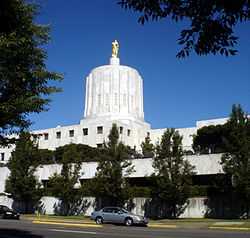Trowbridge & Livingston
Trowbridge & Livingston was an architectural practice based in New York City in the early 20th century. The firm's partners were Samuel Breck Parkman Trowbridge (1862–1925) and Goodhue Livingston (1867–1951).[1]
Trowbridge's father was a military engineer, who oversaw construction of Fort Totten Battery, and repairs to Fort Schuyler during the American Civil War. After the War, he became professor of dynamic engineering at Yale.
Trowbridge himself studied at Trinity College in Hartford, Connecticut. On graduating in 1883, he attended Columbia University, and later studied abroad at the American School of Classical Studies in Athens and at the École des Beaux-Arts in Paris. On his return to New York, he entered the office of George B. Post.
Goodhue Livingston, from a distinguished family of colonial New York, received his undergraduate and graduate degrees from Columbia during the same period Trowbridge was at the school. In 1894, Trowbridge, Livingston and Stockton B. Colt formed a partnership that lasted until 1897 when Colt left, and the firm became Trowbridge & Livingston.

The firm designed several notable public and commercial buildings in the city. Among the most famous are the neo-Baroque St. Regis Hotel (1904) and the former department store for B. Altman and Company (1905), both on Fifth Avenue; the 37-story Bankers Trust Company Building (1912) at 14 Wall Street; and the J. P. Morgan Building (1913), across the street at 23 Wall Street.
Their practice extended to townhouses on Manhattan's Upper East Side, of which 11 East 91st Street and 49 East 68th Street (1914) remain. The New York Society Library, a lending library with a long genteel tradition in New York, moved into the former John Rogers House at 53 East 79th Street.
Other projects in New York included
- Engine Company 7, Ladder Company 1, FDNY (1905), 100 Duane Street (NYC Landmark);
- Knickerbocker Hotel (1906);
- Extension to the New York Stock Exchange (1923);
- 44 Wall Street (1927);
- The Hayden Planetarium (1935) at the American Museum of Natural History, West 81st Street and Central Park West.
- John S. Rogers House, 53 E. 79th St. New York Trowbridge & Livingston
- J. P. Morgan & Co. Building, 23 Wall St. New York Trowbridge & Livingston
- New York Stock Exchange, 11 Wall St. New York Trowbridge & Livingston
Outside the city Trowbridge & Livingston designed
- Jordanville Public Library (1907–1908), Jordanville, New York, listed on the National Register of Historic Places (NRHP)[2]
- The Gulf Building, now Gulf Tower (1932), Pittsburgh, Pennsylvania, in association with E. P. Mellon;
- The Oregon State Capitol (1936–38) in Salem, in association with Francis Keally, NRHP-listed[2]
- American National Red Cross, 17th and D Sts., NW Washington, D.C. Trowbridge & Livingston, NRHP-listed[2]
- United States Post Office and Courthouse (Pittsburgh, Pennsylvania), Jct. of 7th and Grant Sts. Pittsburgh, Pennsylvania Trowbridge & Livingston, NRHP-listed[2]
References
- ↑ New York Architects: Trowbridge & Livingston
- ↑ 2.0 2.1 2.2 2.3 "National Register Information System". National Register of Historic Places. National Park Service. 2010-07-09.
